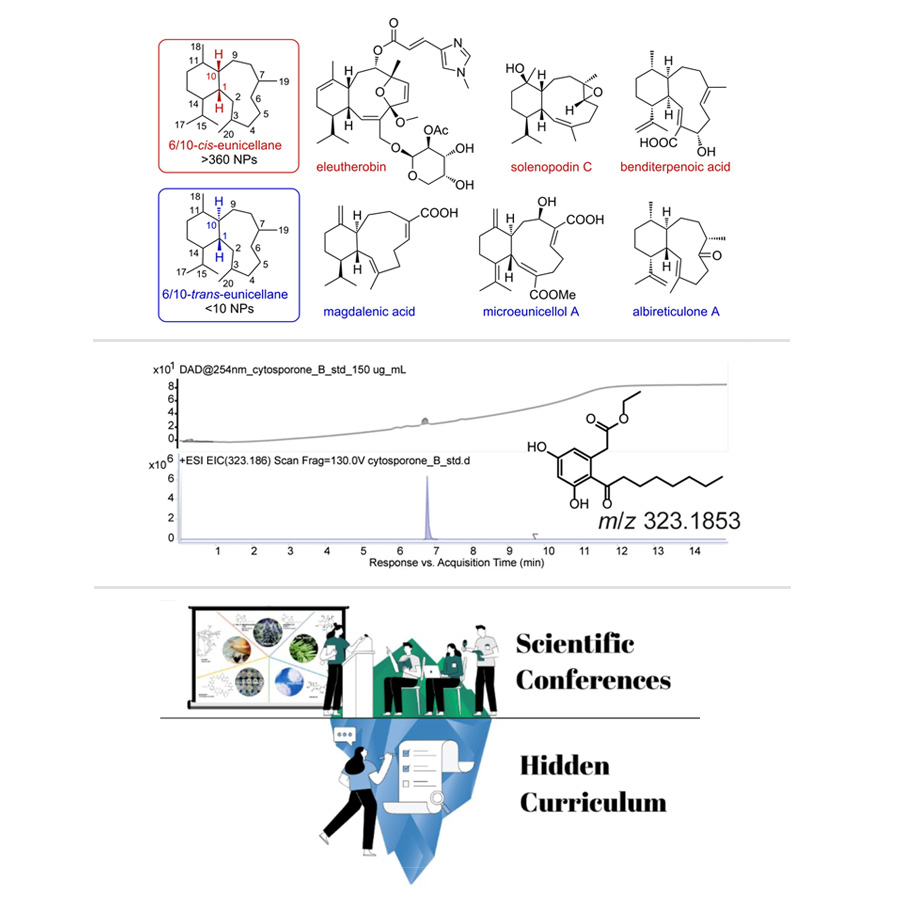
Congratulations to the Loesgen Lab for their recent papers that include a research article on bacterial compounds called eunicellanes (Whitney Laboratory - Dr. Sandra Loesgen and Erin Marshall and UF Rudolf Lab), support for a Florida Seagrass study (Dr. Sandra Loesgen, former Whitney lab postdoc Dr. Annika Jagels), and an article on how to navigate the academic curriculum - best approaches for scientific conferences from the American Society of Pharmacognosy.
Beilstein Journal of Organic Chemistry
Computation-guided scaffold exploration of 2E,6E-1,10-trans/cis-eunicellanes
ABSTRACT
Eunicellane diterpenoids are a unique family of natural products containing a foundational 6/10-bicyclic framework and can be divided into two main classes, cis and trans, based on the configurations of their ring fusion at C1 and C10. Previous studies on two bacterial diterpene synthases, Bnd4 and AlbS, revealed that these enzymes form cis- and trans-eunicellane skeletons, respectively. Although the structures of these diterpenes only differed in their configuration at a single position, C1, they displayed distinct chemical and thermal reactivities. Here, we used a combination of quantum chemical calculations and chemical transformations to probe their intrinsic properties, which result in protonation-initiated cyclization, Cope rearrangement, and atropisomerism. Finally, we exploited the reactivity of the trans-eunicellane skeleton to generate a series of 6/6/6 gersemiane-type diterpenes via electrophilic cyclization.
Frontiers in Marine Science
ABSTRACT
Thalassia testudinum has undergone die-offs in the past century due to seagrass wasting disease caused by Labyrinthula sp. Little is known about how seagrasses resist Labyrinthula infections, but metabolites that inhibit Labyrinthula were previously extracted from seagrass leaves. Furthermore, leaf fungal endophytes from seagrasses possess antipathogenic potential, but their activity against Labyrinthula is unknown. Here, we aimed to identify whether fungal endophytes of T. testudinum can aid in disease defense against Labyrinthula. Through Illumina amplicon sequencing of the leaves’ mycobiome, we identified fungi that are known to produce antimicrobials. We also isolated and extracted organic compounds from endophytes to test their anti-Labyrinthula potential using disk diffusion assays. There were 22 isolates that inhibited Labyrinthula, from which two isolates, Trichoderma sp. P1a and Diaporthe sp. M14, displayed strong inhibition. LC-HRMS/MS analysis determined the likely bioactive compounds of Trichoderma as peptaibols and of Diaporthe as cytosporone B. Cytosporone B was confirmed bioactive against Labyrinthula via disk diffusion assays. While these organisms are low in abundance in the mycobiome, this study demonstrates that seagrass endophytes have the potential to play an important role in defense against Labyrinthula.
Journal of Natural Products
Outlining the Hidden Curriculum: Perspectives on Successfully Navigating Scientific Conferences
ABSTRACT
Outlining the Hidden Curriculum: Perspectives on Successfully Navigating Scientific Conferences Scientific conferences and meetings are valuable opportunities for researchers to network, communicate, and develop knowledge. For early career scientists, conferences can also be intimidating, confusing, and overwhelming, especially without having adequate preparation or experience. In this Perspective, we provide advice based on previous experiences navigating scientific meetings and conferences. These guidelines outline parts of the hidden curriculum around preparing for and attending meetings, navigating conference sessions, networking with other scientists, and participating in social activities while upholding a recommended code of conduct.